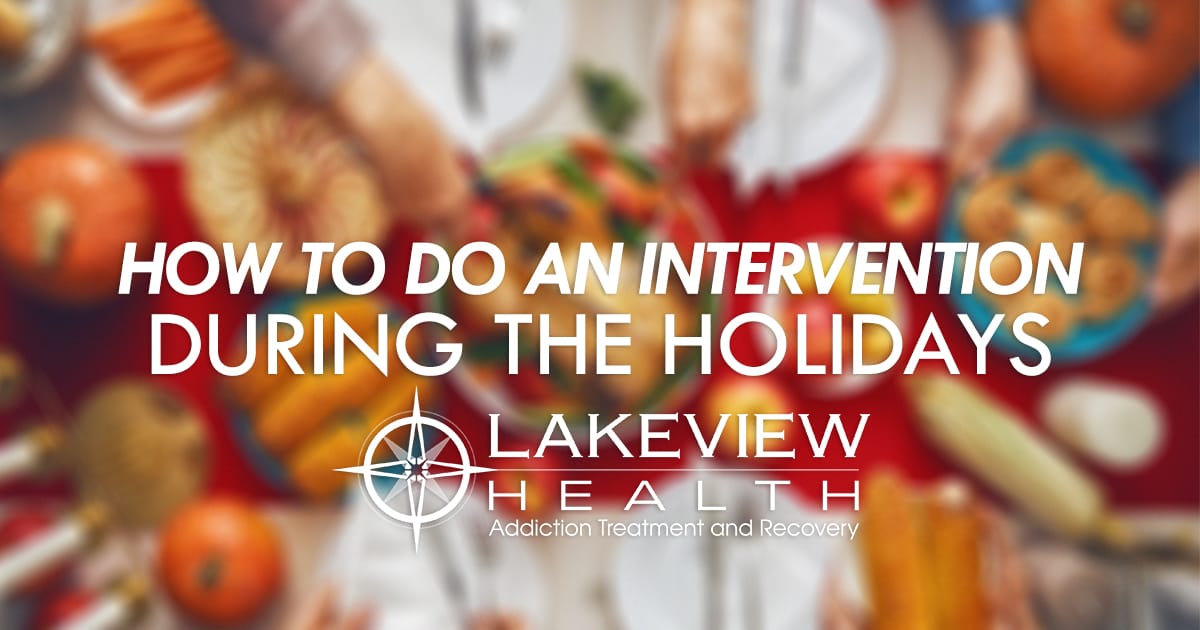

By: Lakeview Health
An intervention can be a powerful tool to help a family member or a friend find help for a problem like addiction. Knowing how to do an intervention is vital, especially with the added stress of the holidays. The intervention meeting needs to be carefully planned and prepared, though. Otherwise, it can leave the situation unchanged or, in some cases, even exacerbate the problem. Below we have a list of drug or alcohol intervention strategies to help your loved ones.
Don’t Delay Because of the Holidays
Perform the intervention as soon as possible. Don’t delay it because the holidays are coming up. The holiday season can easily bring stressful confrontations with family members, and stress is a key risk factor for substance use disorders. Drug overdoses increase significantly during the holidays. Delaying an intervention that could lead to treatment can be dangerous for your loved one. Instead of fighting with you over their drug and alcohol use, the addicted person could realize the holidays are a great opportunity to give the gift of sobriety.
Steps to Prepare for an Intervention
1. Gather Your People
Ideally, you would hire an interventionist to lead this discussion and process with your loved one. Your interventionist can work directly with Lakeview Health to ensure a seamless transition from the intervention to treatment. This step is crucial for getting your loved one the immediate help they need and not creating an opportunity for them to think about it and back out. In addition to an interventionist, you’ll want to think about the people that should be included in the intervention. Create a group. Form a team of people important to the addicted individual. The group (typically six to eight people) can consist of friends, family, coworkers, and others that are currently or were formerly in the addict’s life. These people will be united by their shared concern and love for the user. In the case that you don’t have an interventionist, select a chairperson to facilitate the process and to ensure that everybody is on the same page.
2. Do Your Homework
Collect information. Educate yourself. Since fighting something you don’t understand is fairly difficult, gathering information ahead of the intervention is crucial. If members of the group do not understand the disease of addiction and the ramifications of drug and alcohol misuse, the chance of success will be modest at best. Consulting reliable sources of addiction and the substance used can yield helpful tips regarding the best course of action. You can find out more about addiction and recovery via our vast collection of addiction resources or download our free ebooks and guides with in-depth information.
3. Set a Clear Goal
If the substance use disorder is severe, the goal of the intervention should be to convince the addicted person to accept treatment.
4. Write Intervention Letters
In order to keep things focused and ensure everyone’s contribution is heard, many intervention specialists recommend group members write a letter to be read aloud during the meeting. Intervention letters are a great tool in helping people with addiction realize how their actions affect their friends and families. Writing such a letter is often the most challenging part of the process. The Lakeview Intervention Guide has some tips and a sample letter to get you started. The letter should demonstrate your care and concern for the addicted person, describe the negative impact of the substance abuse, and offer treatment options.
5. Plan the Session
If you have your team in place and everybody is well informed about the reason for the intervention, it is time to plan the meeting. Decide as a group where the intervention should take place and who should be in attendance. Determine how you can get the addicted person to be present. Decide what will be said by the participants. Anticipate objections by the addicted person. For instance, if they say, “I’m not on drugs” or “My drinking is under control,” have a response ready. Rehearse your responses.
Don’t Derail Your Intervention: Avoid These Mistakes
- Performing the intervention when the addicted person is intoxicated or experiencing significant withdrawal symptoms.
- Having the intervention informally, one-on-one, or without preparation.
- Being confrontational, aggressive, or overly emotional. This can trigger a defensive stance.
- Allowing the intervention to spiral out of control or deviate from the goal.
- Letting your loved one leave the intervention to think it over. Ideally, the decision to go to treatment will happen at the intervention.
Remember Your Goal
Remember, the goal of the intervention is to cause a change in the addicted person’s substance use and behavior. That change should come quickly. If the addiction is severe, this will probably necessitate treatment in a rehab facility. Even if the addicted person refuses to choose that option, it is important to emphasize that recovery is the only way forward and that you are there to help. But if they choose the gift of recovery, it might just turn out to be the best holiday gift ever for the entire family.
Free Intervention Guide
[cta_btn url=”https://lakeviewhealth.multiplica.dev/wp-content/uploads/2018/12/free-intervention-information-guide-what-is-an-intervention.pdf” title=”FREE GUIDE” align=”left”][/cta_btn] Our intervention guide provides information, tips, and advice for the family and friends of an individual who is struggling with a drug or alcohol problem.





